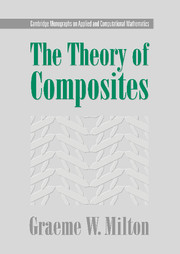Book contents
- Frontmatter
- Contents
- List of figures
- Preface
- 1 Introduction
- 2 Some equations of interest and numerical approaches to solving them
- 3 Duality transformations in two-dimensional media
- 4 Translations and equivalent media
- 5 Some microstructure-independent exact relations
- 6 Exact relations for coupled equations
- 7 Assemblages of spheres, ellipsoids, and other neutral inclusions
- 8 Tricks for generating other exactly solvable microgeometries
- 9 Laminate materials
- 10 Approximations and asymptotic formulas
- 11 Wave propagation in the quasistatic limit
- 12 Reformulating the problem of finding effective tensors
- 13 Variational principles and inequalities
- 14 Series expansions for the fields and effective tensors
- 15 Correlation functions and how they enter series expansions†
- 16 Other perturbation solutions
- 17 The general theory of exact relations and links between effective tensors
- 18 Analytic properties
- 19 Y-tensors
- 20 Y-tensors and effective tensors in electrical circuits†
- 21 Bounds on the properties of composites
- 22 Classical variational principle bounds
- 23 Bounds from the Hashin-Shtrikman variational inequalities
- 24 Bounds using the compensated compactness or translation method
- 25 Choosing the translations and finding microgeometries that attain the bounds†
- 26 Bounds incorporating three-point correlation functions†
- 27 Bounds using the analytic method
- 28 Fractional linear transformations as a tool for generating bounds†
- 29 The field equation recursion method†
- 30 Properties of the G-closure and extremal families of composites
- 31 The bounding of effective moduli as a quasiconvexification problem
- Author index
- Subject index
27 - Bounds using the analytic method
- Frontmatter
- Contents
- List of figures
- Preface
- 1 Introduction
- 2 Some equations of interest and numerical approaches to solving them
- 3 Duality transformations in two-dimensional media
- 4 Translations and equivalent media
- 5 Some microstructure-independent exact relations
- 6 Exact relations for coupled equations
- 7 Assemblages of spheres, ellipsoids, and other neutral inclusions
- 8 Tricks for generating other exactly solvable microgeometries
- 9 Laminate materials
- 10 Approximations and asymptotic formulas
- 11 Wave propagation in the quasistatic limit
- 12 Reformulating the problem of finding effective tensors
- 13 Variational principles and inequalities
- 14 Series expansions for the fields and effective tensors
- 15 Correlation functions and how they enter series expansions†
- 16 Other perturbation solutions
- 17 The general theory of exact relations and links between effective tensors
- 18 Analytic properties
- 19 Y-tensors
- 20 Y-tensors and effective tensors in electrical circuits†
- 21 Bounds on the properties of composites
- 22 Classical variational principle bounds
- 23 Bounds from the Hashin-Shtrikman variational inequalities
- 24 Bounds using the compensated compactness or translation method
- 25 Choosing the translations and finding microgeometries that attain the bounds†
- 26 Bounds incorporating three-point correlation functions†
- 27 Bounds using the analytic method
- 28 Fractional linear transformations as a tool for generating bounds†
- 29 The field equation recursion method†
- 30 Properties of the G-closure and extremal families of composites
- 31 The bounding of effective moduli as a quasiconvexification problem
- Author index
- Subject index
Summary
A brief history of bounds derived using the analytic method
Bergman (1978) recognized that the analytic properties discussed in chapter 18 on page 369 provide a powerful tool for deriving bounds. He rederived the Hashin-Shtrikman bounds and obtained new bounds correlating different properties of composites. A major success of the approach was that it lead to tight bounds on the complex dielectric constant of a two-phase composite (Milton 1979, 1980, 1981a; Bergman 1980, 1982). These bounds are illustrated in figure 27.1 on the next page. [The first available bounds on complex dielectric constants were those of Schulgasser and Hashin (1976), but they were limited to materials with low-loss constituents, that is, with permittivities having small imaginary parts.] These complex dielectric constant bounds have been directly compared with experimental measurements: Niklasson and Granqvist (1984) applied them to bounding the optical properties of composite films; Korringa and LaTorraca (1986) applied them to bounding the complex electrical permittivity of rocks; Golden (1995) applied them to bounding the complex permittivity of sea ice; and Mantese, Micheli, Dungan, Geyer, Baker-Jarvis, and Grosvenor (1996) applied them to bounding the complex dielectric constant and magnetic permeability of composites of Barium Titanate and ferrite. In most cases the experimental measurements were consistent with the bounds. However, it is important to recognize that these bounds apply only in the quasistatic limit where the wavelength of the radiation is much larger than the inhomogeneities of the microstructure; see Aspnes (1982). McPhedran, McKenzie, and Milton (1982); McPhedran and Milton (1990); and Cherkaeva and Golden (1998) applied the bounds in an inverse fashion to obtain quite tight bounds on the volume fraction from measurements of the complex dielectric constant.
- Type
- Chapter
- Information
- The Theory of Composites , pp. 569 - 602Publisher: Cambridge University PressPrint publication year: 2002



